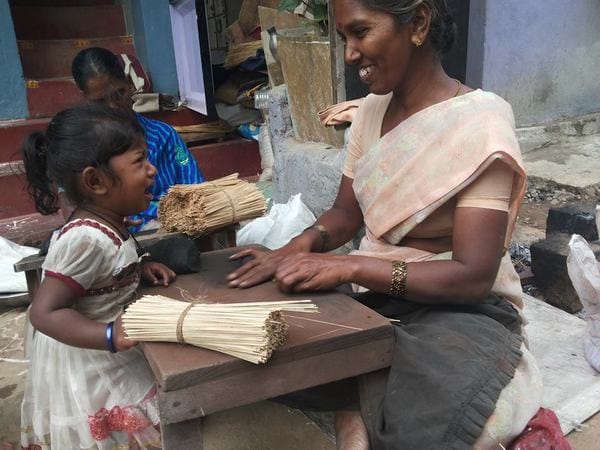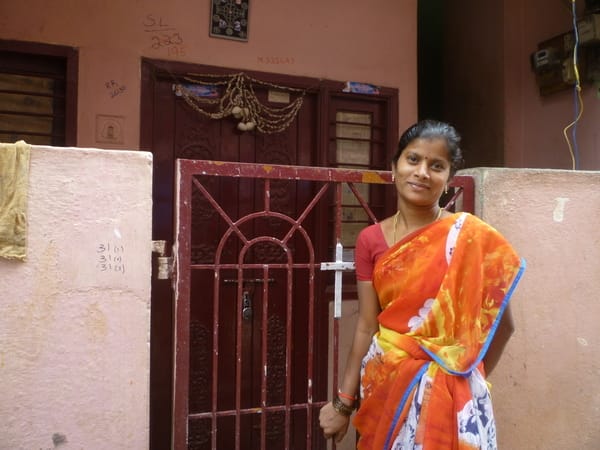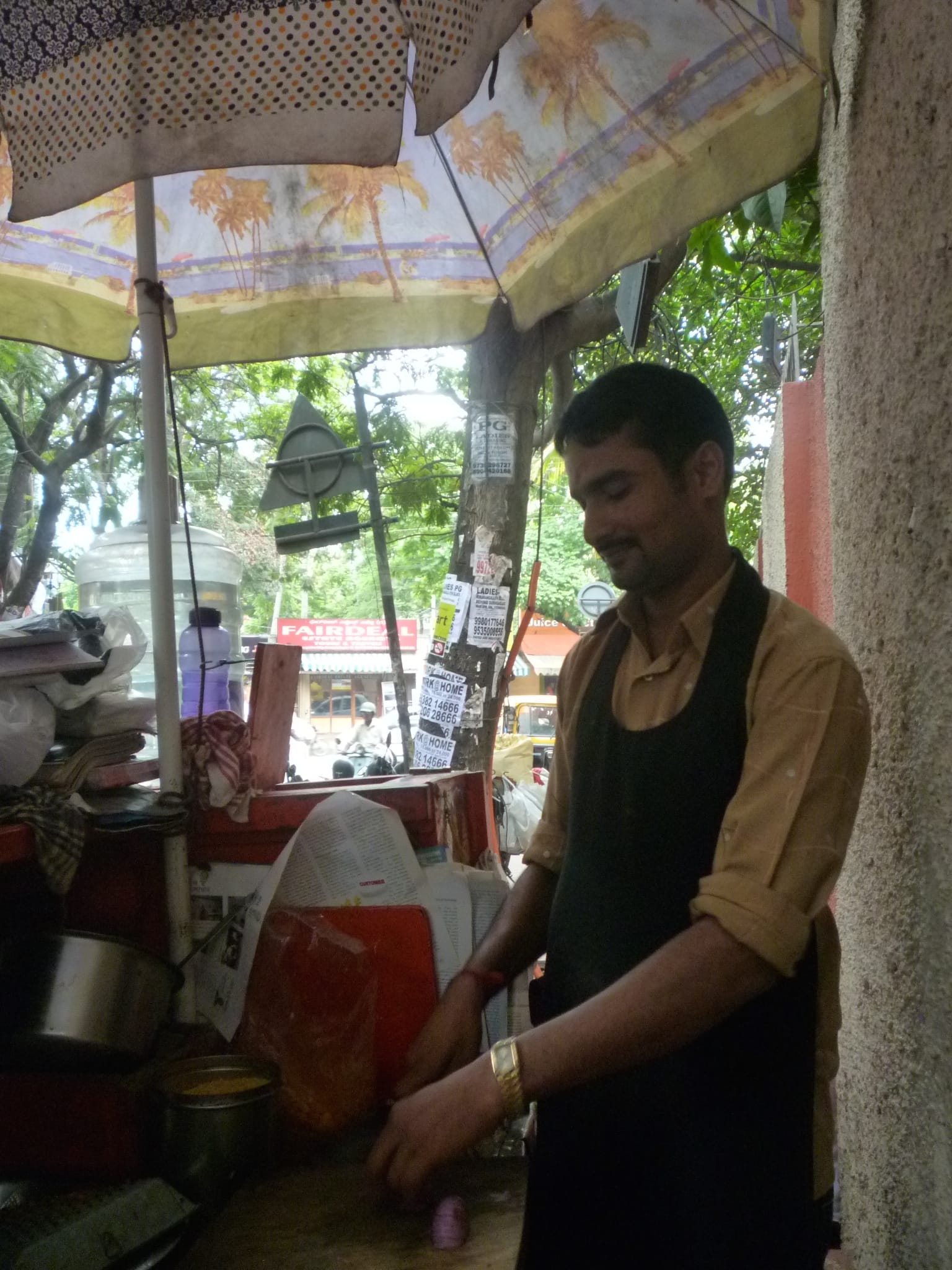
Alamelu works in one of the flats in a nearby apartment complex. After returning to her home in Swatantrapalya, she prepares incense sticks. Pics: Shree D N
Sitting on the floor in her two-room house in Ragigudda EWS quarters, Rajeshwari N, a domestic worker and mother of two, says that she hopes to leave the locality within next two-three years. She has borrowed over Rs 2 lakh to pay the Slum Board for house allotment and to pay off her relatives who wanted to stake claim to the house. Rajeshwari has been living in the area–which was Ragigudda slum earlier–for the last 20 years.
Still, “I want to leave by the time my children are a little older,” she says. The reason is that the locality is unsafe–goons thrive here. Among them, many are those who “recover” loans on behalf of local money lenders. The interest rates are ridiculously high, and those who are unable to repay debts often get assaulted or lose their property. Some residents here are even said to have been forced to give up their allotted houses to money lenders. Fearing the goons, no one speaks up.
Rajeshwari herself has taken many loans in the last 10 years, ever since she got married. She has managed to pay back on time so far. This is not the case with many other women here, like M Uma.
Insanely high interest rates by local moneylenders
Uma’s husband had borrowed Rs 10,000 with weekly interest payment of Rs 1,000 (10% per week) from a moneylender. She says, “He had borrowed without telling me. In around a year, he paid Rs 60,000 only as interest, and could not start paying the principal.”
This Rs 60,000 included a Rs 15,000 that Uma had borrowed from her Self Help Group (SHG) to help pay the loan. One day, the money lender’s goons took away her husband’s Hero Honda bike, saying that he had yet to pay Rs 15,000 and that the bike would make up for it. “We were afraid and did not say anything.” In addition to losing the bike, Uma was left to pay back the debt to her SHG.
Local money lenders visit Bengaluru’s slums often to lend to the poor. They lend to multiple people during one visit, after simply confirming residence of the borrower. Even if interest rates are high, there are always takers.
Rajeshwari says that in Ragigudda, small loans are commonly given at interest rate of 4% per week, for 10 weeks. For instance, for a Rs 200 loan, 20 rupees is cut initially itself as interest, and only Rs 180 is given. The borrower then has to pay Rs 25 weekly, for 10 weeks. Thus for lending Rs 180, the lender finally gets back Rs 250 – i.e, a profit of Rs 70, around 40%, all within 10 weeks.
In Bengaluru’s slums, money is commonly lent at monthly interest rate of 10% which translates to 120% per year. For a Rs 10,000 loan, monthly interest of Rs 1,000 has to be paid until the time that the person can repay the principal. Interest rate may be lesser if the borrower is known to the lender – for example, as a neighbour.
There are also lenders who levy monthly interest rate of 15-20% or even higher. Borrowers keep paying the interest over years, which may add up to several times the principal, and still lose their property, including houses.
Shockingly, many say that lenders get borrowers to sign in a blank bond paper, and later write in a clause that the latter will give the lender his house if he defaults. This ultimately leads to the borrower losing everything and becoming poorer in the process!
Loans for food, events and crises
Mostly the money borrowed is used for routine needs like food, medical treatment and repayment of existing debts. The poor usually can’t get bank loans, and most don’t even have bank accounts.
According to Dr D Rajasekhar, who heads the Centre for Decentralisation and Development at ISEC (Institute for Social and Economic Change), there are four main categories of the working poor in Bengaluru – construction workers, domestic workers, agarbathi rollers and garment workers. Then there are rag pickers, helpers in small businesses and those employed in small manufacturing. Dr Rajshekar has been studying the urban poor since 2008.
He says there are three major reasons for which the poor borrow–food, social events like marriages and festivals, and finally for crises like ill health, accident and death of principal earning member. For the last two categories–social events and crises, average spending may be 10-20 times the monthly income of the person.
In the households that Citizen Matters visited, nearly half the income was spent on food alone. Education was also a major expense–despite poverty, many send their children to private schools and have high aspirations for them. Money is spent on social events due to social pressure and the need to maintain relationships.
Unhygienic living and working conditions may make the poor more vulnerable to illnesses. Lack of quality health care in government hospitals forces them to resort to private hospitals that charge more. Dr Rajshekar says that even the poor who do not engage in any risky behaviour can get into extreme poverty suddenly, upon facing a crisis.
Borrow, spend and borrow again
Due to exploitation by money lenders, most of the poor in Bengaluru have never been debt-free as adults. They manage debts by ‘rotation’–borrowing from one money lender to repay another, and so on. They take multiple loans at a time and live under threat of violence. Monthly expenses are usually higher than their earnings; debts last over a lifetime and may get transferred to the next generation.
With no property to pledge and few social networks to rely on for financial help, the urban poor are often forced to borrow from any available source whenever there is need, irrespective of their ability to repay. “If a poor person has no food, he will worry about food only rather than loan repayment. The poor are very vulnerable, and what is called irresponsible behaviour is actually desperate behaviour due to lack of alternatives,” says Prof M S Sriram, Visiting Faculty at IIM-B.
Loan repayment by ‘rotation’ is a continuous process. Sometimes, monthly interest payment alone is more than the entire household income. Take the case of Mariyal, 33, who lives with her husband and three children in Ejipura slum. Her current monthly household income is Rs 8,500. This is just enough to cover her household expenses—including house rent, food, children’s schoolbooks and electricity bill—Rs 8,000. But her monthly interest payment itself is over Rs 8,000 to four different money lenders for loans adding up to Rs 1 lakh.
Mariyal is in such debt because of her father’s death recently, and two accidents met by her husband, a cab driver for a private company. She had to borrow Rs 50,000 just for repairs of her husband’s car. For her father’s funeral expenses, she borrowed Rs 15,000 and left the city for about two months leading to loss of her two jobs as part-time domestic worker.

Mariyal’s monthly interest payments are higher than her household income. Pic: Navya P K
With this, she lost her own monthly income of Rs 2,000, and now relies only on her husband’s income of Rs 8,500. Her husband’s drinking habit and occasional unwillingness to work make things worse. “I don’t know how to pay [my loans] back. I have to manage everything and there is no one to help me. I have not paid house rent for many months,” she says.
Like many poor, Mariyal pays the money lender before considering household expenses, for the fear of getting harassed. Lenders’ agents come to the area to collect interest. If she does not pay by the 10th of every month, “they will shout and I’ll have to pay extra Rs 1,000 for delay”. If there is an emergency, she has to inform lenders beforehand and get 1-2 days’ extra time. She takes new loans when she cannot manage; and the debts keep piling up.
In fact, she may have nearly paid up the principal for the money lenders’ loans already. For instance, in case of the Rs 50,000 loan, she has already paid up Rs 40,000 only as interest over the last eight months. But since this amount counts only as interest, she will have to keep paying the monthly interest of Rs 5,000 until she can repay the principal.
This is the vicious circle many slum dwellers in Bengaluru are trapped in, and makes them remain poor forever. The educated class in the city has not yet been able to understand what a 30 kg free rice might mean to such a family trapped in financial crunch, for there is no one to tell their story.
Loans are good where dependence is mutual
According to Dr Rajshekar, for loans, the poor first resort to informal sources like employers and then pawn brokers; third comes the option of money lenders. Source of loan may vary by occupation. Domestic workers are more likely to get loans from their employers as their mutual dependency is higher; loans are usually given during a major crisis or for income generation activities. Domestic workers’ tenure of work is longer compared to construction workers.
Construction workers borrow from their mestris, as there is some mutual dependency. They may also get oil, milk etc from local shopkeepers and pay for these together at the end of the week. If such informal credit is unavailable, the poor resort to pawn brokers if they do have any assets. Most commonly, gold is pledged. But it could also be big vessels, brass items, watches, mobile phone, TV, ATM card or ration card. Drivers pledge driving licenses. Interest rates are high, but will depend on the collateral–for gold the rate is lower, for ration card it’s higher.
Some needy low income category people manage to find licensed lenders whose interest rates are low. H M Suresh, a street vendor selling chaat near Jyoti Nivas College in Koramangala, gets loans at monthly interest of 5-6% from such lenders. Also the Secretary of Koramangala Beedi Vyaparigala Sanghatane, Suresh came to know about licensed lenders from his network of vendors. These are secured loans – house agreement or a third person should be security.

H M Suresh, Secretary of Koramangala Street Vendors’ Association, manages to borrow from licensed money lenders. Pic: Navya P K
Suresh uses part of the loans for investing in his business, but business gets hit during evictions by the police and during college’s summer holidays.
Atrocious circle of meter baddi system
There is also the meter baddi system in which, if the borrower defaults on interest payment, the next interest rate will be based on the principal plus the defaulted interest. For eg, if the loan amount is Rs 50,000 with monthly interest of Rs 5,000, and if the borrower does not pay interest for 10 months, the interest would then be calculated on Rs 1 lakh (Rs 50,000 principal plus Rs 50,000 defaulted interest).
Loans with daily interest rate of 10% are given to vendors in KR Market. For eg., a vegetable vendor can borrow Rs 1,000 in the morning and pay Rs 1,100 in the evening. Prof Sriram says that this is not as bad as it sounds, as these are working capital loans (used to finance day-to-day operations of a business rather than long-term investment). Lending cycle of these loans are shorter and they yield quick returns. High interests are viable for such loans.
But this kind of loan works only in certain context at a certain scale. “A vendor buys vegetables in bulk for Rs 1,000 in the morning and sells it in small quantities. By evening, she may make Rs 1,300 (30% profit), and can afford to pay Rs 100 as interest for her loan. But if she borrows Rs 2,000, she will have to get a new cart and staff, manage leftover vegetables etc., which is not viable,” says Prof Sriram.
However, only a few poor borrow for working capital. According to Dr Rajshekar, only 15-20% of the working poor invest their loans directly to set up or maintain income-generating ventures. “Most poor don’t have such options. Those few who take such loans do so for their children, as they themselves are old and have no incentive to invest,” he says.
While high interest loans are fine for working capitals, Sriram says that loans for purposes with long-term benefits (like education) should have low interest rates.
When compared to the ridiculously high rates, bank loans are available starting from 10% annual interest—10% annually translates to less than 1% interest per month. Even personal bank loans start from 12% annual interest, and rarely go above 20% even in private banks like HDFC.
Thus the interest rates that the poor pay are much higher than those paid by the middle class, who have access to bank loans. So why aren’t the poor offered bank loans? Why are banks neglecting this sector? Look out for part 2 of the series: Here’s why bank loans are like stars in the sky for poor
Related Articles
Running to raise money for the lake where they train!
Who killed Muniyappa?
Aged 6, weighing 12kg, she dies a quiet death
Two more kids aged 7, weighing 12 kg, found in D J Halli
14-year-old girl fills blind mother’s life with light, while her own stars remain bleak
Here’s why bank loans aren’t meant for Bengaluru’s poor
When micro-finance and self help groups make things worse for poor in Bengaluru
Navya, Buzz India runs an NGO in Bangalore which teaches people financial skills so they can decrease their dependence on moneylenders like these. They’ve already done spectacular work in rural spaces in Karnataka. Please have a look at their website and maybe put this community’s leader in touch with them too. http://www.buzzindia.co
Well written. The article covers the plight of poor labour and self financed street vendors.
The lady working as a domestic helper in our house has explained her plight in this regard. She is a Christian and always seek the help of her parish priest for guidance at the time of need. When her mother fell ill, it was the Church which helped her settling part of the Hospital bill. With the financial support from the houses she work, she has brought up her two sons to college level. She told another source which helps her at the time of need. It is “Ujjivan microfinance institution”. She is a member of this and gets loans from them regularly. Plight of the poor in our Country is pathetic. It is good our PM has taken some positive steps to alleviate the suffering. But how far the benefits reach the needy is a big question.